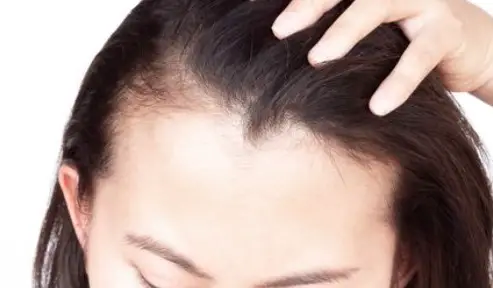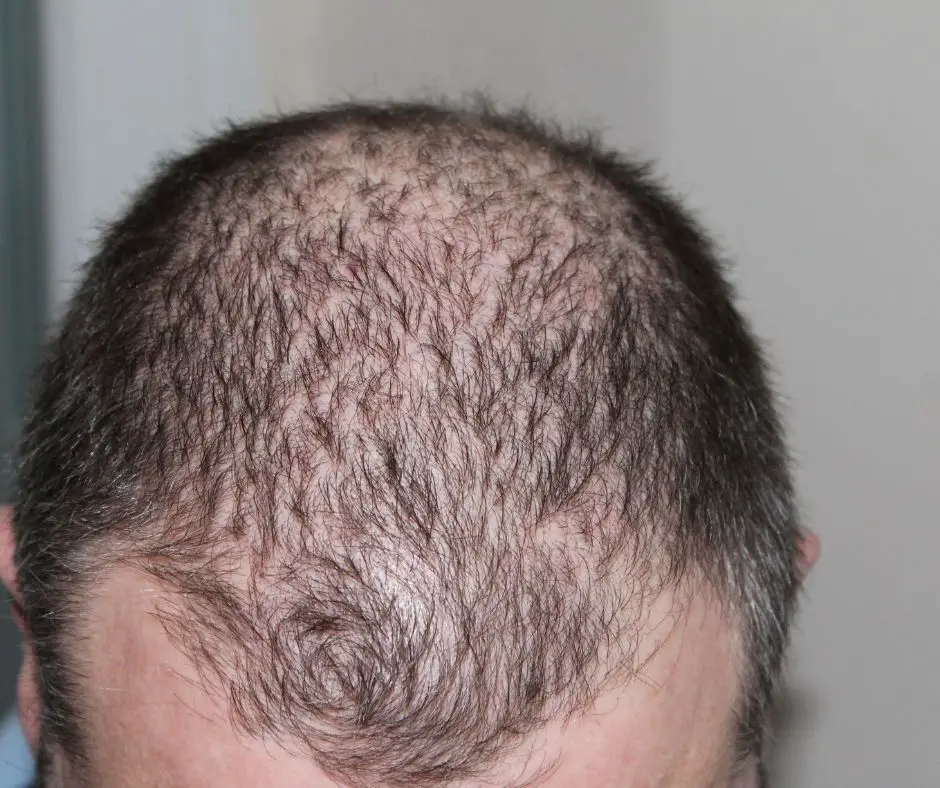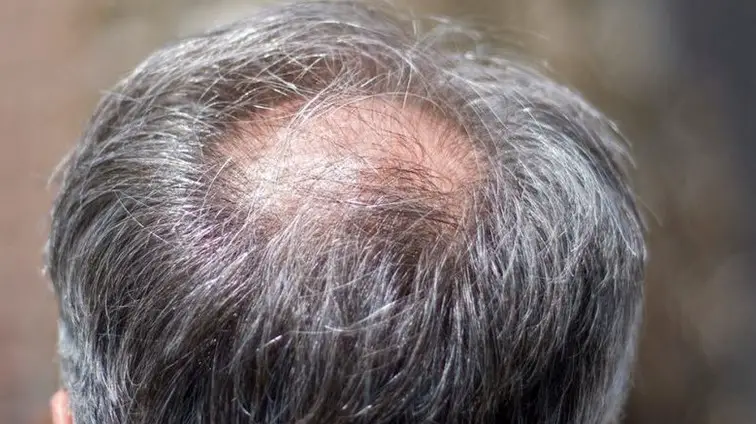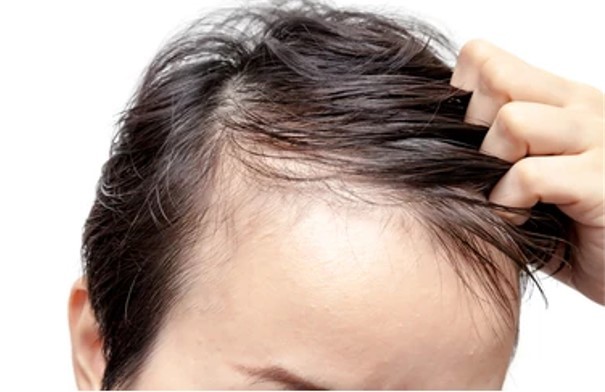How to tell if you’re balding by taking a look at old photos and ask your family and friends if you are unsure. If you notice visible changes over time (for example within a year) with the thinning of the hair, visible scalp, you may go bald. This could be due to several reasons like (genetics and more below, on top of that, says Stages of Balding), but if there is a history of hair loss on either side of your family, it might be inevitable to experience early signs of balding at 20.
There are several disorders, such as hormone changes related to pregnancy, giving birth, menopause, and thyroid issues, that might cause permanent or temporary hair loss.
Alopecia areata involves medical problems (al-o-PEE-she-are-tuh) and immune-system-related causes of blotchy hair loss if you have (scalp infections such as ringworm) and a hair-pulling disorder called trichotillomania (trik–o–til–o–MAY-nee-uh). Hair loss is not something to worry about if it is a sign of a disease.
Normal crown vs thinning crown
When you’re looking at hair loss, one of your biggest concerns is whether or not you have enough of it. Hair thinning is more insidious, as it often goes unnoticed until it’s too late. But thinning can be spotted early, if you know what to look for. The first sign of a thinning crown isn’t actually visible hair loss. The first warning sign is an unusually thick crown – or top section – of your head.
Men with less hair on their heads usually compensate by growing thicker, coarser strands in a bigger area. Not only does that make hair loss harder to spot, but it also makes them feel less like they’re going bald because their scalp looks so big. Instead of worry about that being a bad thing, concentrate on treating any damage-causing condition causing your shedding and consider using minoxidil or finasteride products; these two meds seem to stimulate follicles as they grow back lost hairs — especially finasteride because its half-life (the amount of time before your body rids itself of it) is much longer than minoxidil’s five hours.
Balding or cowlick
If you’re balding or cowlicking, it may be hard to notice your hair loss at first. When your hair starts thinning, you may just think it’s a new hairstyle or even blame it on genetics. However, as more and more hair begins to fall out, you might notice an increasing amount of scalp showing through your growing stubble. Ultimately, if you see that bald spot forming in a mirror—the one that just won’t go away—there are solutions for getting fuller locks again. See our guide for 7 tips on how to grow thicker hair if you want more information about reversing hair loss naturally.
Hair whorl or balding
A hair whorl is a circle or spiral of hair on a balding or thinning scalp. If you notice one, it may mean you’re starting to go bald at that spot. Some men are able to cover up a hair whorl with longer hairstyles, but if your receding hairline keeps exposing it, there’s no getting around it. If you have receding hairline and notice new areas of baldness or thinning elsewhere on your head, now would be a good time to speak with your doctor about what options are available for treating male pattern baldness in men.
Normal crown hair
While you might not see your normal crown hair in its entirety, it is still there. This is often referred to as vertex baldness or male pattern baldness. Treatments for male pattern baldness can actually reverse hair loss, but they’re most effective when used while there are still a few thin areas on your scalp. If you have no thinning areas at all, you may not want to undergo treatment. While treatments can slow down your hair loss, they won’t make it grow back on their own.
Crown balding
If you notice a widening gap between your hairline and your forehead, you may be developing crown balding. The early signs of crown balding are often mistaken for other conditions such as acne, psoriasis or eczema, according to Men’s Health. Crown baldness isn’t quite as noticeable as vertex baldness but can be just as damaging to your self-esteem. Since it develops at a very young age (typically around 18 years old), crown baldness usually causes younger men a great deal of stress.
Androgenetic Alopecia
Male pattern balding or Androgenetic alopecia, is the most common form of progressive hair loss in men. This hereditary disease, which occurs with ageing, occurs in a predictable pattern, with a receding hairline and bald patches in men and thinning hair on the crown and scalp in women. It is also known as androgenic alopecia, male baldness or female baldness.
Treatment options
According to a meta-analysis published in the 2017 Journal of the American Academy of Dermatology (JAAD) in journal of the American Academy of Dermatology, minoxidil finasteride Low-level laser therapy (LLLT) was superior to placebo for hair regrowth and researchers concluded that it promotes hair growth more effectively in men with male hair loss. DHT is the hormone responsible for hair loss in men who tend to lose their hair. If you notice hair loss and want to stop it, one of the most effective ways to block the hormone DHT that causes hair loss is to use a combination of finasteride and minoxidil in a hair-thickening shampoo.
How to Tell if You’re Balding Signs

The most common signs of how to tell if you’re balding are not always reliable, which makes it easy to confuse normal hair loss (undamaged hair follicles that regrow) with male pattern baldness. Bald patches and a receding hairline remain two of the most important early signs of balding. Repeated signs of balding cannot be reliably detected either.
Below are 8 signs of balding which you should know about and a number of simple and effective solutions to avoid hair loss.
Sign 1. Female/Male pattern baldness
This is when the scalp starts to become visible. The beard is affected by Alopecia areata, and men with this condition may develop one or more bald spots in their beard area. The most obvious sign of balding is a noticeable change in the hairline that you can see.
Sign 2. Itchy scalp
This is not a typical sign of male pattern baldness but can be a sign of other conditions that can contribute to hair loss, including a build-up of sebum or oil on the scalp or skin conditions such as folliculitis, psoriasis, and seborrhoeic dermatitis. Alopecia areata can also cause hair loss: some people develop ribbons or sloughs of bald skin on the scalp, known as ophiasis (oh-fee-ah sis). Frequent scratching in these cases can damage the hair follicles and promote fallout.
There are a few ways to stop (or at least slow) male pattern baldness by keeping a close eye on thinning, retreating hair lines and excessive hair loss, but if you take it easy, you can see some of the false alarms we have listed below. If you notice that you lose your hair, take the steps we have talked about in this article to help you control your male baldness. You may notice that the hair on your crown thins after years, so it is worth taking action now to prevent further loss.
Sign 3. Your Hair Takes Longer To Grow
Your scalp hair grows about six inches a year- which means you’ll be adding a couple of inches of hair every few months. You’re right to be concerned that male pattern baldness or MPB can affect the speed of this growth, but there’s not enough research to show how.
However, baldness can also affect hair count. For instance, if it takes longer for your hair to grow back properly after shaving or some other treatment, this is a sign that you probably have male pattern baldness.
Maybe you might notice that your hair doesn’t look as thin as it used to — a problem caused by hair follicles damaged by DHT high-level.
Sign 4. Your Hair is Falling Out
Excessive hair shedding is a common sign of hair loss. Even though it’s easy to see, most people miss it because they assume their pet just needs a good brushing. This is because hair loss usually occurs on a daily basis – the hair sheds naturally as it reaches the later stages of its growth cycle.
Because it is normal for some hair to come out, you’ll often feel a few stray hairs on your brush or pillowcase. This does not necessarily mean you are going bald.
However, if you notice a lot of hair around the house or stuck in your shower drain, it may be time for some hair loss treatments.
Sign 5. Thin Hair on the Sides of the Head
The thinning hair that is on the sides of the head can be caused by ageing, hereditary, and an underlying medical condition.
There are a few things to consider when you have thinning hair on the sides of your head. The first thing is to make sure that you aren’t just going bald. This usually occurs in men who have male pattern baldness. The other possibility is that you are getting older and your hairline has receded back from where it once was. If you’re losing hair without obvious cause or treatment on a regular basis, it could be hereditary thinning or signal an underlying medical condition like thyroid disease. It’s important to pay close attention and see a doctor when this happens.
As we age, we lose some of our natural abilities to grow new hairs in all areas across our scalp.
Sign 6. Thinning Locks Around the Crown
The hair thinning is a common side effect of chemotherapy. The hair that has been lost may grow back eventually, but in some cases it may not.
Chemotherapy is a type of cancer treatment that uses drugs to kill cancer cells by stopping them from dividing. It does this by affecting the way the cancer cells grow and divide, or by stopping them from producing necessary proteins.
We should be cautious about how we deal with the issue of thinning locks and work with our hair stylists on finding a suitable hairstyle for us. It is important to have a head full of healthy and shiny hair, so make sure you don’t let your worries get in the way of looking good!
Sign 7. Receding Hairline and Hair Loss On The Temples, Forehead, and Back of the Head
The first sign that someone is losing hair is when their hairline starts to recede. This begins as a recession in the temples, a thinning of the hair on the forehead, and an increased balding on the back of the head. As this progresses, more and more hair sheds. The scalp’s skin becomes less elastic because there are fewer hairs anchoring it to its follicles. This makes it easier for these hairs to fall out, even with gentle touch or wind exposure.
Sign 8. Your Scalp is Clearly Visible
Did you use to have very thick hair that covered your scalp like the Amazon rainforest? It is common for this type of hair to grow quickly and cover your head in teens and early twenties.
Male pattern baldness can cause your head of hair to thin. This means that when wet, parted, styled with wet look products or just on its own, the scalp will become visible.
Hair loss occurs during a process aptly known as “miniaturization”. Even if you are not seeing any apparent changes to your hairline, your hair still might be in the process of thinning.
For some men, male pattern baldness is first noticed at the crown — or the top of their head. You might notice that when you look at your hair from behind in a mirror, you can see skin through the hair.
The hairline moves back from the forehead, with 31% of men aged 40-55 showing some signs.
One common side effect of this form of hair loss is that you’ll be more at risk to sunburn. This is because wearing hats outdoors can keep your scalp from being exposed to sunlight.
Am I Going Bald? How to tell
Hair loss can happen for a variety of reasons. However, in men, the most common cause is an androgenetic alopecia, which is also known as male pattern baldness. Male pattern baldness happens due to your genes and hormones called the androgens.
In some men, the hormone Dihydrotestosterone (DHT) can bind to receptors in the scalp and cause hair follicles to shrink. This effect progressively reduces your hair production until you are mostly bald.
Our guide about DHT & hair loss can fully explain why the latter happens and where it originates from. Other factors like stress, medication or skin infection can also lead to hair loss in some cases. We’ve covered that in some detail.
How To Stop Your Balding
Male hair loss is mostly genetic, driven by the male sex hormone, testosterone. About 95% of men will experience hair loss by age 50.
Starting off, it’s important not to let yourself become stressed about losing your hair. Hair loss is something that can happen to all of us and with modern medicine, you can protect yourself from hair loss and keep on top of your current head of hair.
The biggest problem surrounding male pattern baldness and hair loss isn’t finding the right treatment plan – it is the lack of awareness and misinformation floating around. You would be surprised at how many men feel powerless once they notice that they’re starting to lose their hair.
Despite what’s told to many people, homeopathic treatments like rubbing cayenne pepper and apple cider vinegar on the head will not cure them of their hair loss.
However, it doesn’t mean that you need to admit defeat and allow yourself to lose hair. There are various scientifically-backed hair loss treatments available and are worth investigating as an option for treating baldness.
Right now, the most proven medications for treating male pattern baldness are minoxidil (the active ingredient in Rogaine®) and finasteride (Propecia®).
Minoxidil is a topical treatment that can stimulate hair growth, while finasteride is an oral medication that reduces the amount of DHT.
Both of these medications are often used together to prevent hair loss from worsening, shield your hair from further damage, and even regrow hair in the thinner areas of your scalp that you might have lost.
We have a special Hair Power Pack which includes minoxidil, finasteride and other products that have been scientifically proven to be effective for treating hair loss.
Although these medications are effective, they will not solve your baldness. To keep your hair looking healthy and full, you’ll need to keep using minoxidil and finasteride regularly over the long term.
You may need to wait a few months before seeing any improvements in your hair health from minoxidil or finasteride.
How Long Does it Take to Go Bald?
Going bald isn’t something that happens overnight. For most men, hair loss develops gradually over the course of many years and decades. Your hairline will gradually recede and your scalp will slowly grow less hairy as days go by.
There’s no set amount of time it takes to go bald. Each person is different, and for some people hair loss can happen quickly, while others experience slower but steady hair loss.
Regardless of how quickly or slowly you’re going bald, it’s important to treat hair loss as soon as you can in order to prevent further hair loss and maintain the health of your current hair.
- AI Powered Bald Filter Online 2024: See Yourself with No Hair! - January 19, 2024
- Harklinikken Bad Reviews 2024: Analyzing Negative Feedbacks - January 18, 2024
- How to Get the Alex Eubank Hair | Step-By-Step Tutorial 2024 - January 18, 2024







